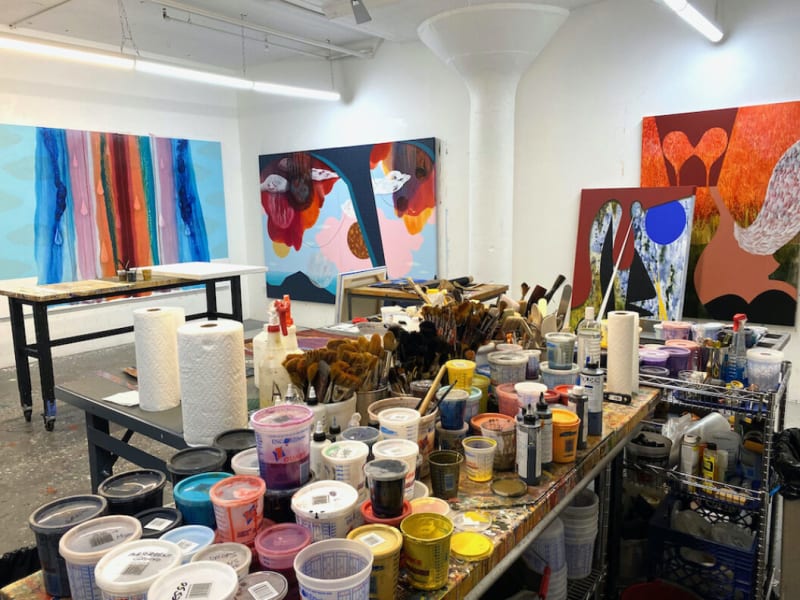I’ve followed New York painter Carrie Moyer’s work for a couple of decades, and it’s been exciting to see her ongoing experimentations with paint, different textures, techniques, and references. I’ve also been taken by how she continuously, in one way or another, brings her feminist and activist politics into her various bodies of work. As a fellow painter, I’m inspired by her radical investigations and her approach to painting as an inquiry.
Many abstract painters tend to actively engage with art history, rejecting or incorporating prior ideas, including their own. I love how artists’ works can contain that very conversation with themselves; the next generation will then continue it and that keeps the history moving and fresh. In Moyer’s work, for instance, a brushstroke receiving a shadow is one way in which she playfully intermixes abstraction with illusion, thereby subverting the genre’s prescriptions.
Visiting my peers’ studios is one of my favorite things about being an artist in New York City: I get insight into how others think and explore, and then go to the show that comes out of it. When we recorded this conversation in Moyer’s studio this fall, she was in the middle of working on several paintings in various stages of completion. It’s a privilege to see an artwork before it receives its final touches. I also got to witness how Moyer’s process occasionally involves the computer. She scans her paintings, or creates forms on the screen, then prints them out and moves them around on the canvas, not unlike a Matisse cutout. This was one of several revelations I took away from the studio visit.
—Bruce Pearson
Bruce Pearson: How great to be in your studio.
Carrie Moyer: I’m very happy to have you here.
BP: I’m wondering what’s going on with this new work.
CM: I have two paintings that I’m doing that are part of a commission, which are these over here. I’m gonna move the furniture so you can see them. They’re diptychs, which is not a form I usually work in but they need to fit into a particular space in some- one’s home. I’m thinking of them as Carrie Moyer’s greatest hits, since each contains aspects of the work that I’ve been dealing with for a long time, be it landscape or imaginary place, or an approach to abstraction that buries figuration or imagery in it.
BP: How do you mean, “buries figuration”?
CM: I’m always embedding things that are recognizable into my pours or large swaths of color. Part of it is to create a treasure hunt for the viewer. It’s very important for me to slow the viewer down and pose questions, like, What do I know I’m looking at, and what don’t I know? And then create this tension that the viewer has to resolve. Asking, How do these things operate? And why are they in the same space? There seems to be this very arbitrary border between “abstraction” or “representation,” which is completely porous at this point, and even using the words feels totally inadequate. I don’t know what those terms are describing anymore.
BP: I’ve been kind of obsessing about binaries and wanting to just wipe them out in my thinking because they’ve gotten us into so much trouble. Right now, there seems to be a wider acceptance of things that don’t fit into categories; there’s a willingness to redefine things.
CM: One of the joys of this work is using paint to play with the history of illusion, but also talking to all these other moments in painting history. Flatbed planes, staining, monoprinting, tricky surface treatments, impossible light and shadow effects. The stuff in my bones about modernism rejects the things that give us great joy in painting, like illusion. (laughter)
BP: This painting on the right seems to invite you in, but there’s also resistance—you think you get a handle on something, and then it just slips away. Looking slow rewards the viewer.
CM: That’s my goal. I guess I’m interested in cultivating the long view of painting. I’m rejecting the “I spent three minutes looking at your painting on Instagram and now I get it” mode. These over here are new works that I started this summer. This one is finished, that one is in process. I’m interested in returning to some of the work I was making in the ’90s that was more blatantly related to posters. I’m using collages and other stuff, mining my own archive.
BP: Over the phone, you mentioned that you felt that you were on the edge of a breakthrough. Has that happened yet? What is it?
CM: I’m one of these painters who is painting to find something out. I go at a picture thinking there’re going to be these reference points—for example, some of these collages—that help me set up a structure. Then, the process of making it becomes revealed. I’m always responding to what I’m looking at. With these new ones, I don’t know if it’s a breakthrough, but it’s a definite move because I’m using things that I’ve discovered about paper over the past two years and trying to bring them into painting. I’m setting up a very complex surface before I even put anything on it: all these canvases have a fiber paste on them, so they actually feel dry and papery.
BP: For a ground?
CM: Yeah, as a ground. It’s very textured, and it responds to the paint really differently. So I’m getting results that on paper are quite beautiful, but in a painting, they look gnarly. That is not usually part of my painting vocabulary, and I’m really liking that.
...
Read full interview at bombmagazine.org.

